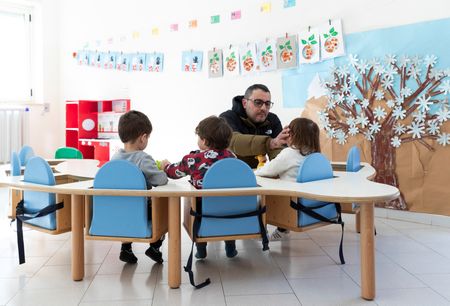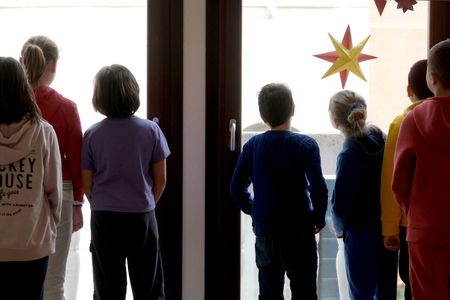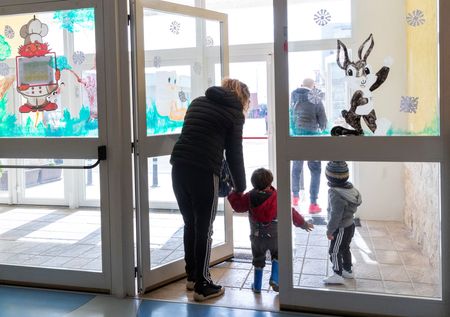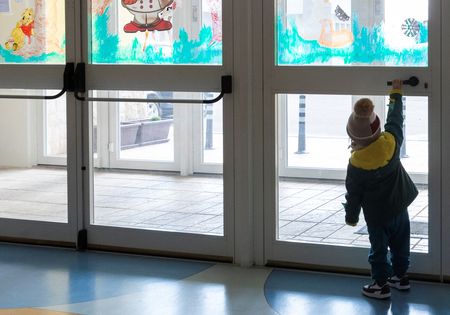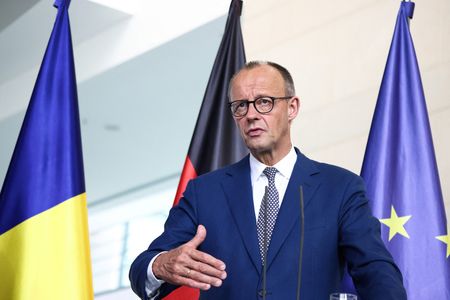By Giuseppe Fonte and Angelo Amante
ROME (Reuters) – When Italian Prime Minister Giorgia Meloni took office in 2022 she inherited a double whammy – the country not only had a worryingly low birthrate, but also low female employment levels.
In an effort to help reverse both trends and boost economic growth, Meloni promised a birth support plan and pledged to create more affordable childcare, confident that this would ease worries about the cost of having babies, and free up mothers to enter the workplace.
But things have not gone to plan, with the twin curses of Italian bureaucracy — red tape and administrative delays — forcing Meloni’s government to hastily downgrade the project.
The funding is coming from a pool of 194.4 billion euros ($203 billion) in cheap loans and grants that the EU offered Italy to help it recover from the COVID pandemic. The catch is that the money is supposed to be allocated by the end of the spending plan in 2026 and Italy has already revised its programme four times.
Slow spending of the EU funds, a perennial problem in Italy, is one of the reasons analysts say the Italian economy grew a measly 0.5% last year against a government forecast of 1.9% drawn up in 2022, when hopes were high that Italy could leverage the financing to the full.
Economists warn that Italy’s already fragile growth outlook will slide further unless it manages to reverse its low birthrate and boost the number of women in the workforce.
Much of the groundwork for the nursery plan had been laid by the previous government led by Mario Draghi, which in 2021 had earmarked some 4.6 billion euros ($4.80 billion) from the EU COVID funds to spend on kindergarten and pre-school projects with the aim of creating 264,480 new places for infants.
Meloni has already slashed the target for new places by more than 100,000 while cutting the funding to 3.2 billion euros, and the state budget watchdog UPB warned last month that the goal might be cut by a further 17,400 places, with time rapidly running out for the government to either spend the EU money or lose it.
“The big flaw in the management of these funds was that Italy did not want to acknowledge until the last minute that many projects cannot be closed on time,” said Marco Leonardi, an economics professor at Milan’s Statale University and a former aide to Draghi.
‘SPEND ALL THE MONEY’
Meloni is negotiating a fifth, final revision of the original EU fund programme with Brussels and local authorities are afraid that more of the promised childcare facilities will get the chop, deemed too bogged down to hit the tight deadline.
“If administrators are afraid of losing funds, they only have to do one thing: close the tender procedures, do it quickly and spend all the money,” EU Affairs Minister Tommaso Foti told Reuters.
The Treasury aimed to spend just over half of the 194.4-billion COVID windfall by the end of 2024, but Foti said just 64 billion had been invested so far.
Underscoring the need for action, consumers’ union Altroconsumo said in a 2024 report that Italy’s less developed southern regions had places for only 16% of local children, while in Italy as a whole, average coverage was just 28%.
By contrast, the European Union average was 37.9%, with neighbours France and Spain achieving a rate of above 50%.
Some towns and cities have already been forced to revise their initial nursery plans and complain that the complexity of applying for, and then disbursing the EU funds, has made it extremely difficult to meet the demanding timetables.
“Fear is always just around the corner … Every time the government revises the (EU funds) spending plan, it scares those who are not up to speed with the timetable,” said Giovanna Bruno, the mayor of the southern city of Andria.
Bruno, whose city has around 100,000 residents, is set to build two new child facilities using the EU funds, but she was forced to cut off an already planned project after the government reviewed previously agreed financing terms.
LOW FEMALE EMPLOYMENT
Luca Dal Poggetto, an analyst at think tank OpenPolis, said the influx of EU funds meant low-staffed local administrations had to manage around 40% more money than they were used to, making it hard for them to cope with the challenge.
“They proved incapable of applying for the projects, and some of those submitted were not suitable to obtain the funding,” he told Reuters.
But the stakes are high for Italy to rectify its childcare provision. Its demographics are the worst in Europe in terms of economic growth potential between 2023 and 2040, Scope Ratings said last October, with births in Italy falling for a 15th consecutive year in 2023.
That same year, the female employment rate in Italy was just 56.5%, the lowest in the EU.
These statistics make it imperative for Italy to respond, analysts say.
“Increasing nursery schools helps get more women into the labour force,” Milan economics professor Leonardi told Reuters.
“This is crucial to boost economic growth and ensure that there are enough workers to support a growing army of pensioners who also need the state for costly health services.”
($1 = 0.9587 euros)
(Editing by Crispian Balmer and Alison Williams)

